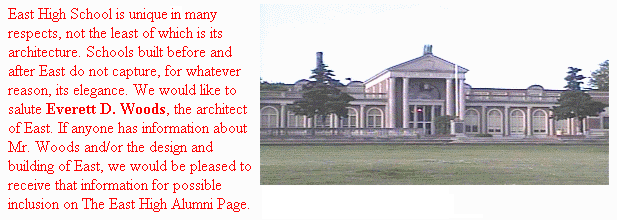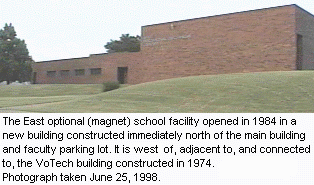

The school grandly sits on top of a hill at Poplar and Holmes, looking from a distance more like a small, wealthy college campus than a high school. -- The Commercial Appeal, 1982

East High School's heritage is apparent when you enter the front door. Marble and rich-toned wood is everywhere. The ceiling is high, the french-styled windows large, the mint-green hallways clean. The Commercial Appeal, 1982
East High was built to accommodate the eastward expansion of the city that burgeoned immediately after World War II, and to house the new school population in an architectural grandeur appropriate to the children of the well-to-do. Woods must have been thinking not only of earlier Memphis schools that were large in scale and classical in style, such as Memphis Technical High School, but also of much grander places, such as Blenheim Palace. The plan is certainly eighteenth-century baroque, with a strong centerpiece flanked by long wings that terminate in pavilions not quite as striking as the main frontispiece.(Johnson, Eugene J. and Russell, Robert D, Jr., Memphis An Architectural Guide, The Univeristy of Tennessee Press, 1990, pp. 305-306.
The building is highly visible from all four sides. Woods invented facades for the east and west which are equal to each other, but subordinate to the main south front. On the north, however, which was the least important of all, he expended relatively little effort. He achieved his effect of grandeur by gluing large classical members onto a simple structure with flat brick walls and large metal sash windows. The stone detailing--particularly those pediments that raise their heads over the utilitarian roof to challenge the sky--gives the flat silhouette and walls a character that belies the plain building beneath. Some of the ornament, closeup, is far from lacking in elegance, particularly the shallow reliefs of urns and swags over the secondary doorways of the south front.
If anyone has a photo of, or knows how we can find a photo of, Architect Everett D. Woods, please contact editor@EastHigh.org.



 another
major stand-alone building added to the campus north of the original
school attached to and west of the vocational building, housing
computer, engineering and health science classrooms and laboratories,
as East becomes an optional school for those areas.
another
major stand-alone building added to the campus north of the original
school attached to and west of the vocational building, housing
computer, engineering and health science classrooms and laboratories,
as East becomes an optional school for those areas.
Everett
D. Woods, East's architect - Although the book Memphis
An Architectural Guide
is not a chronological "history" of Memphis architecture, one can
derive some sense of Everett D. Woods' work around the city. He worked
on a number of mansions around town, but two major landmarks for which
he was chief architect were East High School and Poplar Plaza shopping
center.
Mr. Woods appears to be among those honored by the book as one of
several "wonderful architects of the first half of this century."
Everett D. Woods was the half-brother of Neander Montgomery Woods, Jr.,
an architect who designed some "memorable" houses in Memphis during the
1909-1911 period before moving to Connecticut. Neander Woods was the
son of the minister at Second Presbyterian Church, an interesting
tidbit of information since that church was associated with East for a
period when baccalaureate services for seniors were held there. In
addition, a number of students were members of the church, at least in
the 1960's. George Mahan apprenticed under Neander Woods, and Everett
Woods later worked with Mahan on many projects.
Memphis An Architectural Guide references Everett D.
Woods 22
times. He is listed as an associate architect on 14 projects, most with
George Mahan, Jr. being the chief architect. Woods left the Mahan
organization to work on his own in the late 1930's. The designs with
which Mr. Woods was involved range from stately private homes, to
public housing, to school buildings to a shopping center.
Three very notable projects for which Everett D. Woods is credited as
chief architect are East High, of course, the city's (and one of the
nation's) first shopping centers, Poplar Plaza, and the private home
that is now the headquarters of Harrah's Corporation on Cherry Road
just south of Park Avenue. Woods is also listed as the architect for
Scates Hall at the University of Memphis.
Some of Everett D. Woods projects include:
1921 Scates Hall, University of Memphis, chief architect
1927-29 Dr. W.L. Howard House, 91 West Chickasaw Parkway, associate
architect
1927-28 Horace H. Twiford House, 550 East Parkway South, associate
architect
1927-28 Henry C. Nall House, 2230 North Parkway, associate architect
1927-30 James Edward Stark House,1779 Central Ave., associate architect
1927-28 Mrs. Frank M Crump House, 4030 Poplar, associate architect
1928-31 Second Clyde Van Fossen House, 2925 Natchez Lane (Chickasaw
Gardens) associate architect
1929-30 Dr. D. Harbert Anthony House, 2968 Iroquois Rd. (Chickasaw
Gardens), associate architect
1929 Second John Sneed Williams, Sr. House, 2269 Poplar, associate
architect
1931-32 J. Everett Pidgeon House, 4202 White Oaks Rd., associate
architect
1933 Nellie Pidgeon House, 4275 Nellwood Rd., associate architect
1935-38 Lauderdale Courts public housing, 234-274 N. Lauderdale St.,
associate architect
1935-38 Dixie Homes public housing, 940-990 Poplar Ave., associate
architect
1936 J.S. Speed House, Morningside Park, in association with George
Mahan
1937 Ramelle Van Vleet King House, 3481 North Central Park, associate
architect
1938 Harrah's Entertainment Corporate Headquaters, 1023 Cherry Rd.
(formerly the Everett Cook House), chief architect
1939 Manning Hall, University of Memphis, associate architect
1946 46-48 East High School, 3206 Poplar Avenue, chief architect
1948 West Tennessee Tuberculosis Hospital, in association with another
architectual firm
1949 Poplar Plaza, Poplar and Highland, chief architect
1950 A wing at Brooks Art Museum, which was replaced by new
construction in the 1980's.
Sources:

![]() Return to The East High
Alumni Home Page
Return to The East High
Alumni Home Page